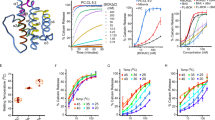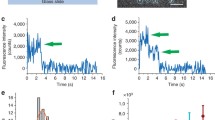Abstract
Both pro-apoptotic Bax and anti-apoptotic Bcl-2 are structurally homologous to the pore-forming domain of bacterial toxins. Bax proteins oligomerize in the mitochondrial outer membranes forming pores that release cytochrome c from the mitochondrial intermembrane space. Bcl-2 proteins also form pores that, however, are much smaller than the Bax pore. It is unknown whether Bcl-2 forms monomeric or oligomeric pores. Here, we characterized the Bcl-2 pore formation in liposomes using biophysical and biochemical techniques. The results show that the Bcl-2 pore enlarges as the concentration of Bcl-2 increases, suggesting that the pore is formed by Bcl-2 oligomers. As expected from oligomerization-mediated pore-formation, the small pores are formed earlier than the large ones. Bcl-2 oligomers form pores faster than the monomer, indicating that the oligomerization constitutes an intermediate step of the pore formation. A Bcl-2 mutant with higher affinity for oligomerization forms pores faster than wild type Bcl-2. Bcl-2 oligomers were detected in the liposomal membranes under conditions that Bcl-2 forms pores, and the extent of oligomerization was positively correlated with the pore-forming activity. Therefore, Bcl-2 oligomerizes in membranes forming pores, but the extent of oligomerization and the size of the resulting pores are much smaller than that of Bax, supporting the model that Bcl-2 is a defective Bax.





Similar content being viewed by others
References
Youle RJ, Strasser A (2008) The BCL-2 protein family: opposing activities that mediate cell death. Nat Rev Mol Cell Biol 9:47–59
Yip KW, Reed JC (2008) Bcl-2 family proteins and cancer. Oncogene 27:6398–6406
Petros AM, Medek A, Nettesheim DG et al (2001) Solution structure of the antiapoptotic protein bcl-2. Proc Natl Acad Sci USA 98:3012–3017
Suzuki M, Youle RJ, Tjandra N (2000) Structure of Bax: coregulation of dimer formation and intracellular localization. Cell 103:645–654
Chou JJ, Li H, Salvesen GS, Yuan J, Wagner G (1999) Solution structure of Bid, an intracellular amplifier of apoptotic signaling. Cell 96:615–624
Choe S, Bennett MJ, Fujii G et al (1992) The crystal structure of diphtheria toxin. Nature 357:216–222
Parker MW, Postma JP, Pattus F, Tucker AD, Tsernoglou D (1992) Refined structure of the pore-forming domain of colicin a at 2.4 a resolution. J Mol Biol 224:639–657
Antonsson B, Conti F, Ciavatta A et al (1997) Inhibition of Bax channel-forming activity by Bcl-2. Science 277:370–372
Schendel SL, Xie Z, Montal MO, Matsuyama S, Montal M, Reed JC (1997) Channel formation by antiapoptotic protein Bcl-2. Proc Natl Acad Sci USA 94:5113–5118
Schlesinger PH, Gross A, Yin XM et al (1997) Comparison of the ion channel characteristics of proapoptotic BAX and antiapoptotic Bcl-2. Proc Nat Acad Sci USA 94:11357–11362
Schendel SL, Azimov R, Pawlowski K, Godzik A, Kagan BL, Reed JC (1999) Ion channel activity of the BH3 only Bcl-2 family member: BID. J Biol Chem 274:21932–21936
Kuwana T, Mackey MR, Perkins G et al (2002) Bid, Bax, and lipids cooperate to form supramolecular openings in the outer mitochondrial membrane. Cell 111:331–342
Dlugosz PJ, Billen LP, Annis MG et al (2006) Bcl-2 changes conformation to inhibit Bax oligomerization. EMBO J 25:2287–2296
Peng J, Tan C, Roberts GJ et al (2006) tBid elicits a conformational alteration in membrane-bound Bcl-2 such that it inhibits Bax pore formation. J Biol Chem 281:35802–35811
Antonsson B, Montessuit S, Lauper S, Eskes R, Martinou JC (2000) Bax oligomerization is required for channel-forming activity in liposomes and to trigger cytochrome c release in mitochondria. Biochem J 345:271–278
Eskes R, Desagher S, Antonsson B, Martinou JC (2000) Bid induces the oligomerization and insertion of Bax into the outer mitochondrial membrane. Mol Cell Biol 20:929–935
Antonsson B, Montessuit S, Sanchez B, Martinou JC (2001) Bax is present as a high molecular weight oligomer/complex in the mitochondrial membrane of apoptotic cells. J Biol Chem 276:11615–11623
Sharpe JC, London E (1999) Diphtheria toxin forms pores of different sizes depending on its concentration in membranes: probable relationship to oligomerization. J Membrane Biol 171:209–221
Zakharov SD, Cramer WA (2002) Colicin crystal structures: pathways and mechanisms for colicin insertion into membranes. Biochim Biophys Acta 1565:333–346
Conus S, Kaufmann T, Fellay I, Otter I, Rosse T, Borner C (2000) Bcl-2 is a monomeric protein: prevention of homodimerization by structural constraints. EMBO J 19:1534–1544
Yin XM, Oltvai ZN, Korsmeyer SJ (1994) BH1 and BH2 domains of Bcl-2 are required for inhibition of apoptosis and heterodimerization with Bax. Nature 369:321–323
Zhang Z, Lapolla SM, Annis MG et al (2004) Bcl-2 homodimerization involves two distinct binding surfaces, a topographic arrangement that provides an effective mechanism for Bcl-2 to capture activated Bax. J Biol Chem 279:43920–43928
Yethon JA, Epand RF, Leber B, Epand RM, Andrews DW (2003) Interaction with a membrane surface triggers a reversible conformational change in Bax normally associated with induction of apoptosis. J Biol Chem 278:48935–48941
Tan C, Dlugosz PJ, Peng J et al (2006) Auto-activation of the apoptosis protein Bax increases mitochondrial membrane permeability and is inhibited by Bcl-2. J Biol Chem 281:14764–14775
Hsu YT, Youle RJ (1998) Bax in murine thymus is a soluble monomeric protein that displays differential detergent-induced conformations. J Biol Chem 273:10777–10783
Hsu YT, Youle RJ (1997) Nonionic detergents induce dimerization among members of the Bcl-2 family. J Biol Chem 272:13829–13834
Janiak F, Leber B, Andrews DW (1994) Assembly of Bcl-2 into microsomal and outer mitochondrial membranes. J Biol Chem 269:9842–9849
Tsujimoto Y, Ikegaki N, Croce CM (1987) Characterization of the protein product of bcl-2, the gene involved in human follicular lymphoma. Oncogene 2:3–7
Chen-Levy Z, Nourse J, Cleary ML (1989) The bcl-2 candidate proto-oncogene product is a 24-kilodalton integral-membrane protein highly expressed in lymphoid cell lines and lymphomas carrying the t(14;18) translocation. Mol Cell Biol 9:701–710
Kim PK, Annis MG, Dlugosz PJ, Leber B, Andrews DW (2004) During apoptosis bcl-2 changes membrane topology at both the endoplasmic reticulum and mitochondria. Mol Cell 14:523–529
Wang Y, Malenbaum SE, Kachel K, Zhan H, Collier RJ, London E (1997) Identification of shallow and deep membrane-penetrating forms of diphtheria toxin T domain that are regulated by protein concentration and bilayer width. J Biol Chem 272:25091–25098
Papini E, Schiavo G, Tomasi M, Colombatti M, Rappuoli R, Montecucco C (1987) Lipid interaction of diphtheria toxin and mutants with altered fragment B. 2. Hydrophobic photolabelling and cell intoxication. Eur J Biochem 169:637–644
Peterson AA, Cramer WA (1987) Voltage-dependent, monomeric channel activity of colicin E1 in artificial membrane vesicles. J Membr Biol 99:197–204
Leber B, Lin J, Andrews DW (2007) Embedded together: the life and death consequences of interaction of the Bcl-2 family with membranes. Apoptosis 12:897–911
Billen LP, Kokoski CL, Lovell JF, Leber B, Andrews DW (2008) Bcl-XL inhibits membrane permeabilization by competing with Bax. PLoS Biol 6:e147
Lin B, Kolluri SK, Lin F et al (2004) Conversion of Bcl-2 from protector to killer by interaction with nuclear orphan receptor Nur77/TR3. Cell 116:527–540
Kolluri SK, Zhu X, Zhou X et al (2008) A short Nur77-derived peptide converts Bcl-2 from a protector to a killer. Cancer Cell 14:285–298
Kirsch DG, Doseff A, Chau BN et al (1999) Caspase-3-dependent cleavage of Bcl-2 promotes release of cytochrome c. J Biol Chem 274:21155–21161
Basanez G, Zhang J, Chau BN et al (2001) Pro-apoptotic cleavage products of Bcl-xL form cytochrome c-conducting pores in pure lipid membranes. J Biol Chem 276:31083–31091
Shinoura N, Yoshida Y, Nishimura M et al (1999) Expression level of Bcl-2 determines anti- or proapoptotic function. Cancer Res 59:4119–4128
Wang NS, Unkila MT, Reineks EZ, Distelhorst CW (2001) Transient expression of wild-type or mitochondrially targeted Bcl-2 induces apoptosis, whereas transient expression of endoplasmic reticulum-targeted Bcl-2 is protective against Bax-induced cell death. J Biol Chem 276:44117–44128
Reed JC (2008) Bcl-2-family proteins and hematologic malignancies: history and future prospects. Blood 111:3322–3330
O’Neill J, Manion M, Schwartz P, Hockenbery DM (2004) Promises and challenges of targeting Bcl-2 anti-apoptotic proteins for cancer therapy. Biochim Biophys Acta 1705:43–51
Labi V, Grespi F, Baumgartner F, Villunger A (2008) Targeting the Bcl-2-regulated apoptosis pathway by BH3 mimetics: a breakthrough in anticancer therapy? Cell Death Differ 15:977–987
Acknowledgments
This work was supported in part by the grant GM062964 from the National Institutes of Health to J. L.
Author information
Authors and Affiliations
Corresponding author
Rights and permissions
About this article
Cite this article
Peng, J., Ding, J., Tan, C. et al. Oligomerization of membrane-bound Bcl-2 is involved in its pore formation induced by tBid. Apoptosis 14, 1145–1153 (2009). https://doi.org/10.1007/s10495-009-0389-8
Published:
Issue Date:
DOI: https://doi.org/10.1007/s10495-009-0389-8




